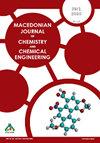多元醇合成银纳米线及其产品的杀菌活性
IF 0.6
4区 化学
Q3 CHEMISTRY, MULTIDISCIPLINARY
Macedonian Journal of Chemistry and Chemical Engineering
Pub Date : 2023-12-25
DOI:10.20450/mjcce.2023.2635
引用次数: 0
摘要
以乙二醇为溶剂和还原剂,硝酸银为银源,聚乙烯吡咯烷酮为生长引导剂、稳定剂和防团聚剂,氯化铜为生长控制剂,采用多元醇法制备了银纳米线。紫外可见光谱、扫描电子显微镜和 X 射线衍射对产品进行了表征。采用圆盘扩散法研究了银纳米线对细菌枯草芽孢杆菌和绿脓杆菌以及真菌黑曲霉和白色念珠菌的杀菌活性。X 射线衍射和扫描电子显微镜显示,除纳米银线外,该产品还含有准球形纳米银颗粒和一些氯化银。根据紫外可见光谱和扫描电子显微镜的结果,估计纳米线的直径为 200-300 纳米。纳米线具有较弱的杀菌活性和较好的杀真菌活性。银纳米线在抑制白色念珠菌的生长方面表现出特别好的活性。本文章由计算机程序翻译,如有差异,请以英文原文为准。
Polyol synthesis of Ag nanowires and biocidal activity of the obtained product
Silver nanowires were prepared by the polyol process with ethylene glycol as a solvent and reducing agent, silver nitrate as a silver source, polyvinylpyrrolidone as a growth-directing agent, stabilizer and agglomeration prevention agent, and copper chloride as a growth control agent. The product was characterized by UV–Vis spectroscopy, scanning electron microscopy, and X-ray diffraction. The biocidal activity of silver nanowires was investigated using the disc diffusion method on the bacteria Bacillus subtilis and Pseudomonas aeruginosa and the fungi Aspergillus niger and Candida albicans. X-ray diffraction and scanning electron microscopy showed that, in addition to silver nanowires, the product also contains quasi-spherical silver nanoparticles and some silver chloride. Based on the results of UV–Vis spectroscopy and scanning electron microscopy, it was estimated that the diameter of the nanowires is 200–300 nm. Nanowires have shown weak bactericidal and good fungicidal activity. Silver nanowires showed particularly good activity in inhibiting the growth of Candida albicans.
求助全文
通过发布文献求助,成功后即可免费获取论文全文。
去求助
来源期刊
CiteScore
1.60
自引率
20.00%
发文量
14
审稿时长
>12 weeks
期刊介绍:
Macedonian Journal of Chemistry and Chemical Engineering (Maced. J. Chem. Chem. Eng.) is an official publication of the Society of Chemists and Technologists of Macedonia. It is a not-for-profit open acess journal published twice a year. The journal publishes original scientific papers, short communications, reviews and educational papers from all fields of chemistry, chemical engineering, food technology, biotechnology and material sciences, metallurgy and related fields. The papers published in the Journal are summarized in Chemical Abstracts.

 求助内容:
求助内容: 应助结果提醒方式:
应助结果提醒方式:


